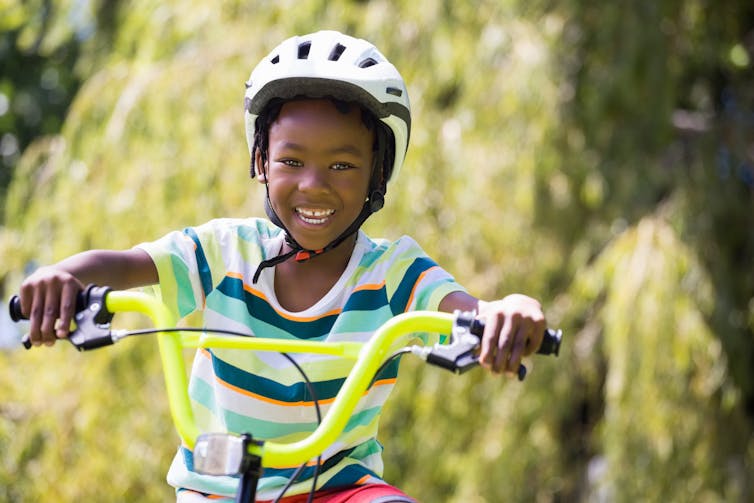¿Por qué es importante la libertad de un niño para viajar y jugar sin supervisión?.
Una disminución en la actividad física de los niños no es una tendencia nueva.
Negin Riazi*,
El Informe de ParticipACTION 2020 recientemente publicado reveló que los niños canadienses obtuvieron una puntuación D + por "actividad física diaria", una F por "juego activo" y una D- por "transporte activo".
Solo el 39% de los niños y jóvenes canadienses alcanzan los niveles recomendados de actividad física.
COVID-19 ha resultado en grandes interrupciones de la vida cotidiana, incluyendo el cierre de escuelas, parques infantiles y parques, que también han limitado el lugar donde los niños pueden jugar, estar activos y estar en la naturaleza, escriben Negin Riazi , Universidad de Columbia Británica y Guy Faulkner , Universidad de Columbia Británica. .
Movilidad de los niños
Estudiamos la movilidad independiente de los niños: la libertad del niño para viajar y jugar en su vecindario sin la supervisión de un adulto . Durante la pandemia, la movilidad independiente de los niños puede ser más esencial que nunca.
La movilidad independiente brinda a los niños muchas oportunidades para experimentar su entorno. Los niños con la libertad de viajar independientemente son más activos físicamente . Sin embargo, la movilidad independiente también proporciona una variedad de beneficios para la salud mental y el desarrollo, incluida una evaluación de riesgos mejorada, una mayor confianza en sí mismo y mejores habilidades de orientación.
 La oportunidad de viajar solo o con amigos les permite a los niños desarrollar mejores habilidades para tomar decisiones. Obtienen la competencia para navegar en su entorno de manera segura y reaccionar de manera apropiada ante incidentes inesperados como perderse. Los padres que permiten la movilidad independiente de sus hijos les están dando confianza para navegar por el mundo por su cuenta.
La oportunidad de viajar solo o con amigos les permite a los niños desarrollar mejores habilidades para tomar decisiones. Obtienen la competencia para navegar en su entorno de manera segura y reaccionar de manera apropiada ante incidentes inesperados como perderse. Los padres que permiten la movilidad independiente de sus hijos les están dando confianza para navegar por el mundo por su cuenta.
En la pandemia actual, la movilidad independiente puede ayudar a los niños a obtener acceso al mundo exterior. Con muchos padres trabajando desde casa, el tiempo al aire libre de los niños puede estar inextricablemente vinculado a cuando los padres tienen tiempo para realizar actividades físicas al aire libre después del trabajo o entre reuniones.
Diferentes cantidades de espacio, movilidad.
No todos los niños tienen acceso a un patio trasero en casa y pueden tener oportunidades limitadas para mantenerse activos. Los niños con movilidad independiente tienen más oportunidades de mantenerse activos caminando o en bicicleta (patinando, patinando o patinando) a varios lugares cercanos a la casa, como el parque local, el patio de la escuela o arriba y abajo de la cuadra del vecindario.
Nuestra investigación destaca que no todos los niños tienen la misma cantidad de movilidad independiente . Por ejemplo, descubrimos en una encuesta a unos 1,700 padres en Vancouver, Ottawa y Trois-Rivières, Que., Que la propiedad del automóvil tuvo influencias negativas en la movilidad independiente de los niños. También el idioma hablado en casa además del inglés o el francés. El idioma que se habla en el hogar puede reflejar normas sociales y culturales, que pueden afectar la movilidad independiente al influir en la toma de decisiones de los padres.
Otra investigación ha señalado que la movilidad independiente a veces es mayor en los barrios socioeconómicos más bajos debido a las diferencias en las normas sociales y los estilos de crianza . La forma en que se puede apoyar la movilidad independiente para los niños con discapacidad es menos segura sin una infraestructura adecuada.
Menor riesgo de COVID-19 al aire libre
Nuestra comprensión de COVID-19 está cambiando rápidamente y la incertidumbre sobre el riesgo para nuestros hijos es estresante. Columbia Británica ahora ha entrado en la Fase 2 de su plan de reinicio y uno de los resultados es la reapertura de parques, playas y parques infantiles.
La Canadian Pediatric Society señala en un informe del 29 de abril que " el principal factor de riesgo para adquirir la infección por COVID-19 en la infancia es la exposición en el hogar ", o contraerla en viviendas compartidas. Es menos riesgoso estar afuera que adentro si se mantiene el distanciamiento físico.
Para apoyar el distanciamiento físico, las ciudades de todo el mundo están reasignando el espacio vial para caminar y andar en bicicleta , abriendo espacios verdes e iniciando zonas libres de automóviles .
En Vancouver , el ayuntamiento votó recientemente para reasignar un mínimo del 11 por ciento de las carreteras de la ciudad al " espacio público centrado en las personas ".
En algunos lugares, los entornos locales pueden estar haciendo un mejor trabajo que otros para aliviar las preocupaciones de seguridad de los padres sobre dejar que sus hijos salgan y jueguen.
Construyendo la movilidad independiente de los niños
Aquí hay siete pasos que puede seguir para ayudar a su hijo y a todos los niños a desarrollar su movilidad independiente.
Obtenga más información sobre nuestra investigación a través de nuestro documental, Running Free . Dicho a través de los ojos de tres familias, explora el concepto de movilidad independiente de los niños, los beneficios de la movilidad independiente para la salud física y mental. Desafía a los espectadores a considerar soluciones para disminuir los niveles de movilidad independiente.
Conozca las restricciones de COVID-19 en su área. Converse con su hijo sobre cómo estar afuera de manera segura sin dejar de seguir las pautas de distanciamiento físico e higiene, tales como: no contacto físico con otros; permanecer a dos metros de distancia; use una máscara cuando vaya a las tiendas; lávate las manos regularmente.
Participe con sus hijos y su comunidad para discutir y abordar las barreras a la movilidad de los niños. ¿Cómo sus hijos, y todos los niños en su comunidad, experimentan movilidad? Conozca y apoye la promoción y planificación para comunidades más inclusivas que apoyen equitativamente la libertad de movimiento y juego de todos los niños.
Empezar temprano. Mientras más tiempo pase su hijo en el vecindario con usted, más familiarizado estará con las calles, los vecinos y el medio ambiente. Con usted, su hijo puede aprender a cruzar la calle de manera segura, andar en bicicleta y superar situaciones inesperadas. Mientras esté fuera, hable con su hijo sobre lo que harían si se perdieran y cómo pedir ayuda o encontrar el camino.
Conozca a su hijo Cada niño es diferente en términos de madurez, confianza y dónde viven. No hay una edad específica en la que un niño debe tener movilidad independiente. Los padres y los niños deben entablar conversaciones para determinar cuándo un niño está listo para explorar su vecindario sin la escolta de los padres y ayudar a su hijo a desarrollar las habilidades para hacerlo de manera segura.
Desarrolle familiaridad con su vecindario. Es beneficioso conocer a sus vecinos, qué lugares están cerca, como espacios verdes, parques infantiles o tiendas, y a quién puede pedir ayuda su hijo si lo necesita. ¿Hay una tienda en la esquina donde un niño que está listo podría enorgullecerse de practicar medidas adecuadas de higiene, uso de máscaras y distanciamiento físico, y hacer un viaje corto para recoger un artículo?
Pruebas de carrera. Una vez que usted y su hijo hayan establecido su disposición, ¡es hora de realizar pruebas! Comience con pequeños pasos. Camine o vaya en bicicleta con su hijo: ayuda a todos a familiarizarse con el vecindario y los lugares de interés. Practique llegar a varios destinos con su hijo abriendo el camino y cruzando la carretera donde sea más seguro. Una vez familiarizado con el vecindario, su hijo puede practicar cómo llegar a varios lugares solo o con sus hermanos, el perro de la familia, con un teléfono celular (o un walkie-talkie) o con un amigo físicamente distante.
Cuando los niños están afuera, " se mueven más, se sientan menos y juegan más" , interactúan con el entorno y aplican su creatividad. Todo esto es beneficioso para su estado físico, salud mental y desarrollo social. Apoyar a los niños para que sean móviles de manera independiente puede ser una solución importante para proteger la salud y el bienestar de los niños.
*Negin Riazi , PhD Candidato en Kinesiología, Universidad de Columbia Británica y Guy Faulkner , Presidente de Salud Pública Aplicada y Profesor, Escuela de Kinesiología, Facultad de Educación, Universidad de Columbia Británica
Este artículo se vuelve a publicar de The Conversation bajo una licencia Creative Commons. Lee el artículo original .




